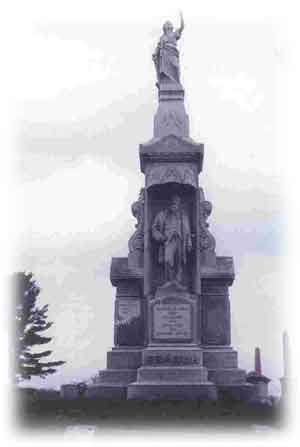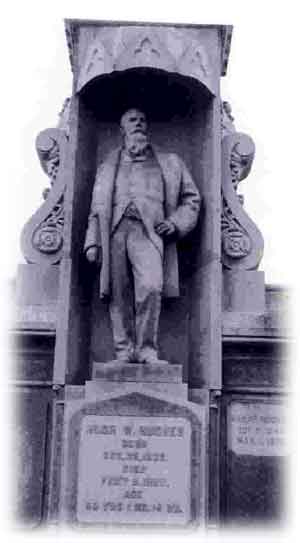The
Story of Hugh Hughes of Nasareth
This
is a copy of an article recently submitted to Ninnau
the Welsh newspaper in North America in 1993 by John
A. Jones, and Joan L. Jones of Granville. Our thanks
to them for allowing us to publish the article.
John
A. Jones runs the slate valley museum in Granville
and has a keen interest in Welsh connections with
the Granville mining history.
Slate
production began in earnest in this valley in the
1850s, bringing many Welsh workers to the area for
the period 1853 - early 1900s. This valley abounds
in their history. The quarries brought many other
immigrants as well, making for a real melting-pot
of cultures. For more information go to www.slatevalleymuseum.org  -
the website is well worth a visit. -
the website is well worth a visit.
Hugh
W. Hughes; "Slate King of America"
One cannot
help but notice the large granite monument to Hugh
W. Hughes which stands in a prominent place in the
Elmwood Cemetery in Middle Granville, New York. Such
was the case when Arturo Roberts of the American
newspaper for Welsh Ex-patriots ' Ninnau' made a
recent visit to the area.
 Arturo’s
questions prompted Joan L. Jones to look up information
on Mr. Hughes referred to as "The Slate King
of America", not only locally, but also in Americans
from Wales by Edward G. Hartman. The History of Washington
County 1737 - 1878 states that " his shipments
in 1876 were twenty three thousand squares of roofing
- slate" enough to be called the "Slate
King!" Arturo’s
questions prompted Joan L. Jones to look up information
on Mr. Hughes referred to as "The Slate King
of America", not only locally, but also in Americans
from Wales by Edward G. Hartman. The History of Washington
County 1737 - 1878 states that " his shipments
in 1876 were twenty three thousand squares of roofing
- slate" enough to be called the "Slate
King!"
On that
monument which overlooks the valley it states that
he was born December 25th 1836 at Trion Pilyn '(Tirion
Pelyn, Plwyf Llanllyfni, Caernarfon, North Wales
is the correct address!)
The files
of the Granville Sentinel, which are contained on
microfilm at the Pember Library in Granville, yielded
the following information exerpted from the Main
Street columns of Morris Rote-Rosen, who wrote about
many prominent and not-so-prominent citizens of the
slate valley.
He was one
of nine children, and 21 years of age when he arrived
in the United States. His wealth was no more than
$5, with which he made his way to Dolgeville, Wisconsin,
where he first found employment in the lead mines.
When he
learned of a growing Welsh settlement in the Mettowee
Valley, he decided to return east. In 1859 he arrived
at Scotch Hill, Fair Haven, Vermont, having heard
about the slate quarries which were more to the liking
of a Welshman, as his native Plwyf Llanllyfni in
Dyffryn Nantlle was a major slate mining area. He
found employment at Vermont and later in nearby Hampton,
New York, on the New York side of the Slate Valley
(which this area is now commonly called).
In 1865,
through frugal living, he had managed to open a quarry
in Fair Haven, Vermont, which he sold a few years
later at a profit of $400. With this 'stake' he then
moved to Granville, New York, and leased a quarry
in Hampton, a few miles north on the north side of
the New York veins. When this proved profitable,
he then invested in another slate quarry on the Whiting
property, across the state line in Vermont.
Good fortune
continued to be his and he opened added quarries
in the town of Pawlet, Vermont, selling several more
at a good profit. He owned several good slate quarries
both in Granville, New York, and in West Pawlet,
Vermont, and became a leader in the business community.
 He purchased
a home which was the show place of Granville. It
stood on the side of the present Pember Library and
Museum, for which he paid $7,000, the largest sum
paid for a home in the area at that time. He added
expensive furniture as well as paintings and antiques
from his native Wales which made his home the 'show-place,
of the whole area. He purchased
a home which was the show place of Granville. It
stood on the side of the present Pember Library and
Museum, for which he paid $7,000, the largest sum
paid for a home in the area at that time. He added
expensive furniture as well as paintings and antiques
from his native Wales which made his home the 'show-place,
of the whole area.
He manufactured
slate on such a large scale as to dispose of 43,000
squares from his own quarries, as well as 14,000
of sea green slate that he purchased from other quarry
operators, and an additional 2,200 squares of red
slate.
In 1875
he helped found the Granville National Bank, the
first in the village of Granville. Two years later
he was made president, an office he held until his
death. He was a leader in local politics, and a member
of the Republican County Committee. He was also a
director of the Salem National Bank in Salem, New
York.
At his death
in 1890, he left an estate valued at $125,000 and
a $15,000 insurance policy. The fortune that he accumulated
was remarkable for two reasons, according to Mr.
Rote-Rosen.
One is that
the average cost to produce a square of slate in
the 1800s was about $2.00 and the average low selling
price of sea green slate was then from $4.00 to $4.25
per square.
The second
reason is that he never attended school when a boy
in Wales as he was forced to work for a living. He
went through life without having been able to read
or write in any language. He only knew how to sign
his name.
Dyffryn
Nantlle is a traditional slate quarrying area, although
the quarries are now closed, the Valley remains a
Welsh language stronghold, with very close communities.
Hugh W.
Hughes and hundreds of young men left the valley
during the nineteenth century to escape having to
work in the slate quarries, owned by rich English
landowners and speculators. Families sent their children
to work the quarries at a very early age, and as
in Hugh W. Hughes case, the only education available
to them was the Welsh Sunday School.
by
O.P Hughes |